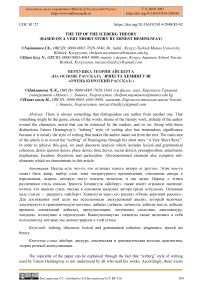The tip of the iceberg theory (based on A very short story by Ernest Hemingway)
Автор: Naimanova Cholpon, Iliyaz Kyzy Nurzat
Журнал: Бюллетень науки и практики @bulletennauki
Рубрика: Филологические науки
Статья в выпуске: 10 т.8, 2022 года.
Бесплатный доступ
There is always something that distinguishes one author from another one. That something might be the genre, choice of the words, theme of the literary work, attitude of the author toward the characters, moral that can be extracted by the readers, and so on. Along with these distinctions Ernest Hemingway’s “iceberg” style of writing also has tremendous significance because it is mostly the style of writing that makes the author stand out from the rest. The main aim of the article is to reveal the “iceberg” of Hemingway through his short story “A Very Short Story”. In order to achieve this goal, we used discourse analysis which includes lexical and grammatical cohesion, deixis (person deixis, place deixis, time deixis, social deixis), presupposition, entailment, implicature, locution, illocution, and perlocution. Aforementioned elements also comprise sub-elements which we demonstrate in this article.
Iceberg, discourse, lexical and grammatical cohesion, pragmatics, speech act theory
Короткий адрес: https://sciup.org/14125960
IDR: 14125960 | УДК: 81’27 | DOI: 10.33619/2414-2948/83/42
Список литературы The tip of the iceberg theory (based on A very short story by Ernest Hemingway)
- Найманова Ч. К. Дискурсивный анализ рассказа Эрнеста Хемингуэя "A Day's Wait" ("Ожидание") // Наука, новые технологии и инновации Кыргызстана. 2018. №6. С. 165-169.
- Найманова Ч. К., Тынчтыкбекова А. Spring as the representation of severities in Ernest Hemingway's "A Farewell to Arms" // Наука, новые технологии и инновации Кыргызстана. 2018. №10. С. 141-145.
- Naimanova, Ch., & Nurzat, Iliiaz Kyzy (2021). Discourse analysis of ernest hemingway's a clean, well-lighted place.Interstudia (Revista Centrului Interdisciplinar de Studiu al. Formelor Discursive Contemporane Interstud), (31), 101-109.


